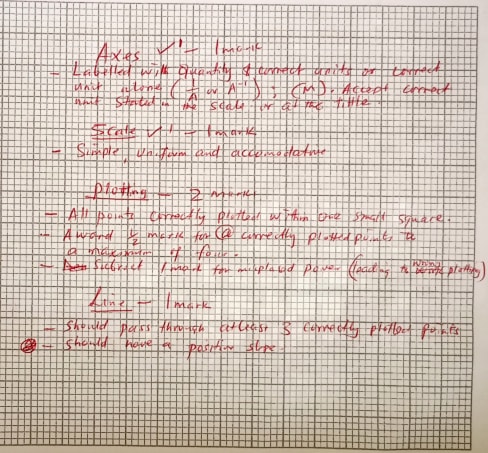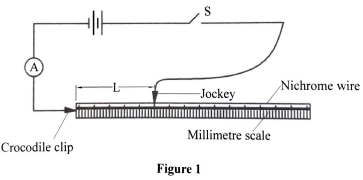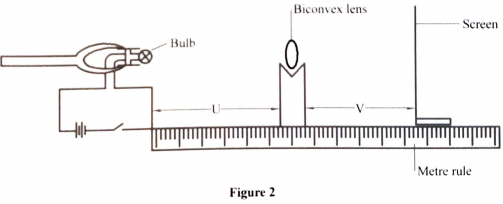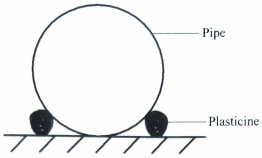Instructions to candidates
- Answer all the questions.
- You are supposed to spend the first 15 minutes of the 2% hours allowed for this paper reading the whole paper carefully before commencing your work.
- Marks are given for a clear record of the observations made, their suitability, accuracy and use.
- Candidates are advised to record their observations as soon as they are made.
- Non-programmable silent electronic calculators and KNEC mathematical tables may be used.
- Candidates should answer the questions in English.
Question 1
You are provided with the following:
- two cells in a cell holder;
- a switch;
- a micrometer screw gauge;
- a nichrome wire mounted on a millimetre scale;
- a voltmeter;
- an ammeter;
- a jockey:
- connecting wires with crocodile clips.
Proceed as follows:
- Using the micrometer screw gauge, measure and record the diameter d of the wire.
d=........mm
d=.........m (1 mark) - Set up the apparatus as shown in Figure 1.
- Using the voltmeter, measure the potential difference E across the battery before closing the switch.
E = ........volts. (1 mark) - Adjust the length L of the wire to 0.1m (10cm). Close the switch, read and record the value of the current I in Table 1.
- Repeat (d) for the other values of L given in Table 1. Complete the table. (6 marks)
Length L (m) 0.1 0.2 0.3 0.4 0.5 0.6 0.7 Current I (A) 1/I A−1 - On the grid provided; plot the graph of 1/I (y axis) against L. (5 marks)
- From the graph, determine the:
- gradient S; (3 marks)
- intercept C on the 1/I axis. (1 mark)
- Given that:
-
determine the value of K1. (2 marks)
determine the value of K2
-
Question 2
You are provided with the following
- a metre rule
- a biconex lens.
- a source of light (bulb in a bulb holder. cells in a cell holder and a switch).
- a stand boss and clamp:
- a lens holder.
- a screen.
- a half metre rule:
- three pieces of plastic pipes A. B and C:
- a vernier callipers (to be shared):
- a stopwatch:
- some plasticine.
Proceed as follows
PART A
- Clamp the bulb holder onto the stand. Arrange the bulb, the lens and the screen along the metre rule as shown in Figure 2.
- Adjust the distance of the bulb from the lens to U = 25 cm. Put on the switch and adjust the position of the screen from the lens so that a sharp image of the bulb is observed. Record the distance V between the screen and the lens in Table 2.
- Repeat part (b) for the other values of U shown in Table 2. Complete the table. (5 marks)
Table 2
U cm 25 30 35 V cm M = V
UF = V
M + 1 - Determine the average value of F. (2 marks)
PART B - Using the vernier callipers measure and record the diameters of the three pipes.
dA, dB and dC
dA =....cm....m (1 mark)
dB =....cm....m (1 mark)
dC =....cm....m (1 mark) - Measure and record the thickness X of the half metre rule.
X = .....cm.....m (1 mark) - Place the pipe marked A on the bench and use the plasticine to stop it from rolling.
(see Figure 3 (a)). - Place the half metre rule onto the pipe such that it balances horizontally. Ensure that the halt metre rule is perpendicular to the axis of the pipe. (see Figure 3 (b)).
- Push one end of the balanced half metre rule slightly downwards and release it so that it oscillates up and down. Measure and record in Table 3 the time for five complete oscillations.
- Repeat the procedure in (g). (h) and (i) for the other pipes B and C. Complete Table 3. (5 marks)
Table 3
Pipe A Pipe B Pipe C Diameter d (m) Time for five oscillations Periodic time T (s) - Determine the average value of Z. (2 marks)

Marking scheme
Question 1
You are provided with the following:
- two cells in a cell holder;
- a switch;
- a micrometer screw gauge;
- a nichrome wire mounted on a millimetre scale;
- a voltmeter;
- an ammeter;
- a jockey:
- connecting wires with crocodile clips.
Proceed as follows:
- Using the micrometer screw gauge, measure and record the diameter d of the wire.
d= 0.29 ± 0.02mm 2 d.p a must 0.27↔0.31
d= 2.9 × 10−4 m (1 mark)
- Conversion of students value correctly.
- Accept standard form to whatever no. of d.p.
- Set up the apparatus as shown in Figure 1.
- Using the voltmeter, measure the potential difference E across the battery before closing the switch.
E = 3.1 ± volts. (1 mark) 1 d.p a must - Adjust the length L of the wire to 0.1m (10cm). Close the switch, read and record the value of the current I in Table 1.
- Repeat (d) for the other values of L given in Table 1. Complete the table. (6 marks)
Length L (m) 0.1 0.2 0.3 0.4 0.5 0.6 0.7 Current I (A) ± 0.10
-2 d.p a must
-Trend decreasing from the 1st correct value0.72 0.53 0.44 0.38 0.33 0.29 0.27 1/I A−1 -Correct reciprocals exact or to 4 s.f
-All correctly done award 1 mark - On the grid provided; plot the graph of 1/I (y axis) against L. (5 marks)

- From the graph, determine the:
- gradient S; (3 marks)
- Δ ✓1
ΔL✓1 Extracting correctly i.e correct interval- Accept transfer of error corrected power of 10
- No line mk no slope mk.
- Accept correct interval and size. It can be deduced from the graph.
- Correct evaluation exact or to 4 s.f (1mk) (A−1 M−1)
- Deny evaluation mark if the unit is wrong: Deny ½ mk for missing units
- Δ ✓1
- intercept C on the 1/I axis. (1 mark)
- Candidates value of C taking into account candidates error transfer either positive or negative with correct units award 1 mark.
- deny ½ mark for missing unit
- C- value should be within the grid.
- Wrong units correct evaluation ½ mark
- gradient S; (3 marks)
- Given that:
-
determine the value of K1. (2 marks)
- Correct substitution S,d and E (any) - Award 1mk
- Correct evaluation exact or 4 s.f -Award 1mk
- Ignore units
determine the value of K2 (1 mark)
- Correct substitution of C and E award ½mk
- Correct evaluation exact or 4 s.f award ½mk
- Ignore units
-
Question 2
You are provided with the following
- a metre rule
- a biconex lens.
- a source of light (bulb in a bulb holder. cells in a cell holder and a switch).
- a stand boss and clamp:
- a lens holder.
- a screen.
- a half metre rule:
- three pieces of plastic pipes A. B and C:
- a vernier callipers (to be shared):
- a stopwatch:
- some plasticine.
Proceed as follows
PART A
- Clamp the bulb holder onto the stand. Arrange the bulb, the lens and the screen along the metre rule as shown in Figure 2.
- Adjust the distance of the bulb from the lens to U = 25 cm. Put on the switch and adjust the position of the screen from the lens so that a sharp image of the bulb is observed. Record the distance V between the screen and the lens in Table 2.
- Repeat part (b) for the other values of U shown in Table 2. Complete the table. (5 marks)
Table 2
U cm 25 30 35 V cm 1d.p
-± 10cm @ 1 mk
-Values with decreasing trend45.0 35.0 30.0 M = V
U-Each value correctly evaluated. Exact or to 4 s.f
-All correct award 1 mk.F = V
M + 1-correct evaluation exact or to 4 s.f
-All correct award 1 mk. - Determine the average value of F. (2 marks)
- Statement of principle of averaging students value shown
- Correct evaluation exact or to 4 s.f award 1 mk.
- Ignore units
PART B
- Statement of principle of averaging students value shown
- Using the vernier callipers measure and record the diameters of the three pipes.
dA, dB and dC
dA = 3.00-3.70cm 2d.p ✓1 correct coversion m ½✓
dB =3.60-4.90cm 2d.p ✓1 correct conversion m ½✓
dC =5.10-5.80cm 2d.p ✓1 correct conversion m ½✓ - Measure and record the thickness X of the half metre rule.
X = 0.50-0.65cm 2d.p ✓1 correct conversion m ½✓ (1 mark) - Place the pipe marked A on the bench and use the plasticine to stop it from rolling.
(see Figure 3 (a)). - Place the half metre rule onto the pipe such that it balances horizontally. Ensure that the halt metre rule is perpendicular to the axis of the pipe. (see Figure 3 (b)).
- Push one end of the balanced half metre rule slightly downwards and release it so that it oscillates up and down. Measure and record in Table 3 the time for five complete oscillations.
- Repeat the procedure in (g). (h) and (i) for the other pipes B and C. Complete Table 3. (5 marks)
Table 3
Pipe A Pipe B Pipe C Diameter d (m) Time for five oscillations ±1 to 2 d.p 1mk@ 12.60 10.60 9.80 Periodic time T (s) -correct evaluation exact or to 4 s.f
-All correct 1 mk.-Each value correctly evaluated ½ mark to a max of 1 mark
-4 s.f or exact
-value of x must be in metres - Determine the average value of Z. (2 marks)
- Statement of principle of averaging of students value shown ✓1
- correct evaluation exact or to 4 s.f (ignore unit) ✓1
- Statement of principle of averaging of students value shown ✓1
- If work is cancelled and replaced, mark the replaced one.
- If work is cancelled and not replaced, mark the cancelled one.
Download Physics Paper 3 Questions and Answers - KCSE 2020 past papers.
Tap Here to Download for 50/-
Get on WhatsApp for 50/-
Why download?
- ✔ To read offline at any time.
- ✔ To Print at your convenience
- ✔ Share Easily with Friends / Students







